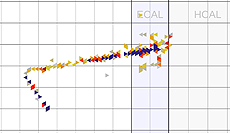The one-percenters and those who fake it
 |
| This is an event from the MINERvA data that shows the signal when an electron neutrino hits a neutron in MINERvA's plastic scintillator, becomes an electron and changes the neutron into a proton. The color in each triangle represents how much energy is deposited in each of MINERvA's triangular scintillator bars. |
Para una versión en español, haga clic aquí. Para a versão em português, clique aqui. Pour une version en français, cliquez ici.
In today's Wine and Cheese seminar, MINERvA will present a measurement of the probability that an electron neutrino interacts with a nucleus inside the MINERvA detector and produces an electron and no other particles besides protons and neutrons. This new result is the first high-statistics measurement of this process at energies comparable to a few times the proton mass.
Neutrino beams made by accelerators produce mostly muon neutrinos, not electron neutrinos. This makes it very difficult to study electron neutrino interactions. The NuMI beam at Fermilab, which is used by MINERvA, MINOS+ and NOvA, is made up of 99 percent muon neutrinos and only 1 percent electron neutrinos. (However, it is so intense that MINERvA still records thousands of electron neutrino interactions each year.)
Because of the relative lack of electron neutrino data, simulation programs assume that the only difference in the interaction probability between muon and electron neutrinos is due to the mass of the muon or electron that is produced. Today's result is the most in-depth look at electron neutrino interaction probabilities ever, and an important check on that assumption.
When we compare our electron neutrino result to the analogous measurement for muon neutrinos that was published in 2013, we find that they are consistent with one another.
This measurement is a very important input for experiments such as NOvA, which measures the probability for muon neutrinos to change into electron neutrinos as they travel from Fermilab to Ash River, Minnesota. To do that, they need to know how many muon neutrinos are produced at Fermilab and how many electron neutrinos reach their detector in Ash River.
The number of neutrinos that reach the NOvA detector is equal to the number of interactions they see divided by the probability that the neutrino will interact. The probability for a neutrino interaction is really tiny and difficult to measure accurately. To get around that, oscillation experiments like NOvA use two detectors, one near where the beam is produced and another far away to give the neutrinos a chance to change flavor. If you take the ratio of interactions at the near and far detectors, the interaction probability cancels out as long as it is the same in both detectors.
Neutrino interactions must be the same in Illinois and in Minnesota, right? The problem is that the neutrinos detected at Fermilab are muon-type, while the far detector sees mostly electron-type neutrino interactions. This means it is important to understand any differences in the interactions between the two types of neutrino.
In the course of searching for electron neutrino interactions, we found an unexpected background of events that look more like photons than electrons but were otherwise consistent with our signal. MINERvA can separate photons and electrons well, so this background has a tiny effect on our electron neutrino measurement. This kind of event is important for oscillation experiments because muon neutrinos that produce photons can be mistaken for electron neutrinos. We have characterized these background events, and believe they are similar to what we would expect from a process called diffractive scattering, where a single neutral pion is produced by a soft collision with the hydrogen in our scintillator target. Our observation and characterization is a first step towards development of a model to predict this process in other experiments.
—Chris Marshall, University of Rochester
 |
| Jeremy Wolcott of the University of Rochester, who is neither a one-percenter nor someone trying to look like one, will describe this result at today's Wine and Cheese Seminar. |
|